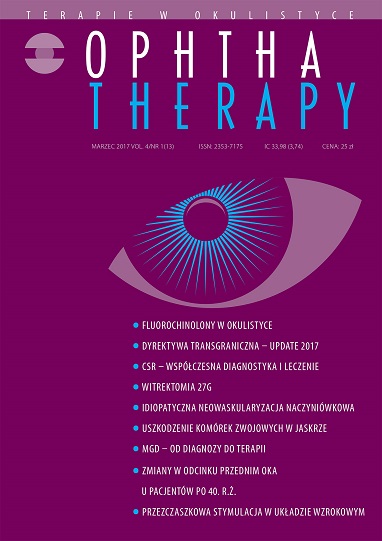Witrektomia 27G – aktualny stan wiedzy
##plugins.themes.bootstrap3.article.main##
Abstrakt
W obecnych czasach witrektomia jest podstawową metodą chirurgicznego leczenia wielu chorób siatkówki, szklistki i styku szklistkowo-siatkówkowego. Na przestrzeni ostatnich kilkunastu lat mamy do czynienia z minimalizacją cięć chirurgicznych w wielu dziedzinach medycyny, w tym w okulistyce. Ma to prowadzić do szybszej rekonwalescencji i zmniejszenia liczby powikłań. Celem niniejszej pracy jest przybliżenie aktualnego stanu wiedzy na temat wymiernych korzyści płynących z minimalizacji cięcia w witrektomii, a w szczególności przedstawienie zalet i wad witrektomii 27G.
Pobrania
##plugins.themes.bootstrap3.article.details##

Utwór dostępny jest na licencji Creative Commons Uznanie autorstwa – Użycie niekomercyjne – Bez utworów zależnych 4.0 Międzynarodowe.
Copyright: © Medical Education sp. z o.o. License allowing third parties to copy and redistribute the material in any medium or format and to remix, transform, and build upon the material, provided the original work is properly cited and states its license.
Address reprint requests to: Medical Education, Marcin Kuźma (marcin.kuzma@mededu.pl)
Bibliografia
2. Goldstein DJ, Oz MC. Current status and future directions of minimally invasive cardiac surgery. Curr Opin Cardiol. 1999; 14: 419-25.
3. Harell AG, Heniford BT. Minimally invasive abdominal surgery: lux et veritas past present and future. Am J Surg. 2005; 190: 239-43.
4. Koh CH, Janik GM. Laparoscopic microsurgery: current and future status. Curr Opin Obstet Gynecol. 1999; 11: 401-7.
5. Lundell L. Anti-reflux surgery in laparoscopic era. Baillieres Best Pract Res Clin Gastroenterol. 2000; 18: 272-7.
6. Oshima Y, Wakabayashi T, Sato T et al. A 27-gauge instrument system for transconjunctival sutureless microincision vitrectomy surgery. Ophthalmology. 2010; 117: 93-102.
7. Rizzo S, Barca F, Caporossi T et al. Twenty-seven gauge vitrectomy for various vitreoretinal diseases. Retina. 2015; 35: 1273-8.
8. Khan MA, Shahlaee A, Toussaint B et al. Outcomes of 27 Gauge Microincision Vitrectomy Surgery for Posterior Segment Disease. Am J Ophthalmol. 2016; 161: 36-43.
9. Mitsui K, Kogo J, Takeda H et al. Comparative study of 27-gauge vs 25-gauge vitrectomy for epiretinal membrane. Eye. 2016; 30: 538-44.
10. Byeon SH, Lew YJ, Kim M et al. Wound leakage and hypotony after 25-gauge sutureless vitrectomy: factors affecting postoperative intraocular pressure. Ophthalmic Surg Lasers Imaging. 2008; 39(2): 94-9.
11. Woo SJ, Park KH, Hwang JM et al. Risk factors associated with sclerotomy leakage and postoperative hypotony after 23-gauge transconjunctival sutureless vitrectomy. Retina. 2009; 29(4): 456-63.
12. Ibarra MS, Hermel M, Prenner JL et al. Longer-term outcomes of transconjunctival sutureless 25-gauge vitrectomy. Am J Ophthalmol. 2005; 139(5): 831-6.
13. Gupta OP, Ho AC, Kaiser PK et al. Short-term outcomes of 23-gauge pars plana vitrectomy. Am J Ophthalmol. 2008; 146(2): 193-7.
14. Fine HF, Iranmanesh R, Iturralde D et al. Outcomes of 77 consecutive cases of 23-gauge transconjunctival vitrectomy surgery for posterior segment disease. Ophthalmology. 2007; 114(6): 1197-200.
15. Scartozzi R, Bessa AS, Gupta OP et al. Intraoperative sclerotomy-related retinal breaks for macular surgery, 20- vs 25-gauge vitrectomy systems. Am J Ophthalmol. 2007; 143(1): 155-6.
16. Hsu J, Chen E, Gupta O et al. Hypotony after 25-gauge vitrectomy using oblique versus direct cannula insertions in fluid-filled eyes. Retina. 2008; 28(7): 937-40.
17. Taban M, Sharma S, Ventura AA et al. Evaluation of wound closure in oblique 23-gauge sutureless sclerotomies with visante optical coherence tomography. Am J Ophthalmol. 2009; 147(1): 101-7.

